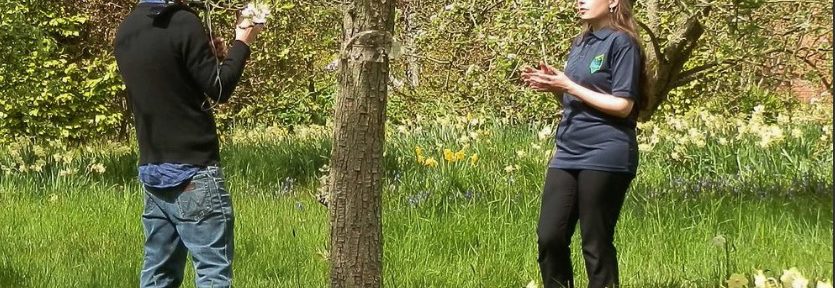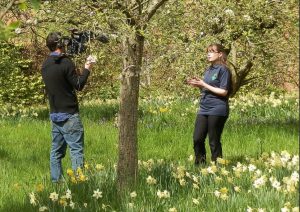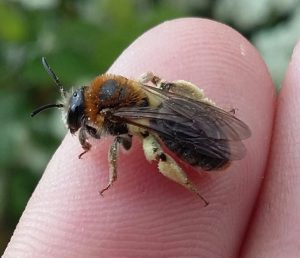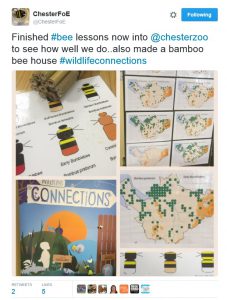
Got started May off with a bang by doing something really exciting (and maybe a little scary) – getting interviewed by a film crew! This was orchestrated by Norton Priory Museum (located in Runcorn, Cheshire), which also happens to have lovely grounds and a beautifully maintained walled garden. They wanted to have a series of interviews with specialists in their field about all the different kinds of wildlife that you can find at the Norton Priory gardens. They were really keen to have someone talk about pollinators and the range of species which can be found in the gardens – so that’s where I came in. These videos are then going to be put on at the museum for people to watch for years to come! Was quite nerve wracking but surprisingly once we actually started my nerves all but disappeared!

Talking about the importance of pollinators to Norton Priory film crew – feeling like David Attenborough for the day!
I had a great time chatting to the film crew about all the different types of pollinators there are – bees, butterflies, moths and hoverflies. About what pollination is and how each species of pollinator are so different yet interconnected with each other.
It helped a great deal that the camera men were genuinely interested in what I had to say. I explained to them how different pollinators are suited to different plant species. An easy way to illustrate this is with common bumblebee species. There are seven commonly found species of bumblebee in the UK and each have a different length of tongue. Which is important as the length of tongue a bee has dictates which flowers it can feed from.
The garden bumblebee had the longest tongue out of the common bumbles about 12mm long – almost the length of it’s entire body! Which it can use to reach the nectar at the very base of very deep tubed flowers like Viper’s Bugloss. Whereas short tongued bees prefer more shallow open flowers – like dandelions – where they can reach the pollen and nectar easily. This causes different bees to specialise on pollinating different plants, acting to reduce competition between different species. I find it really fascinating that some solitary bees have gone even further and have a single plant species or group which they specialise to feed on.
Thankfully the weather on the day of filming was lovely, so I got to actually show the crew some of the different pollinators in the gardens. Several common bumblebees, hoverflies, butterflies and even an active bee hotel – with loads of the solitary Red Mason bees flying in and out! Such a fantastic opportunity to get involved in. Now just to (nervously) await the result and see how it turns out! Fingers crossed!
This month I also started my urban created meadows project. Doing vegetation surveys to quantify available flower resources and link that together with what pollinator species are present on each site. It’ll be interesting to see which species inhabit each site across the season!

Some species can be identified easily in the field. This one is an Orange-tailed Mining bee (Andrena haemorrhoa) female. Look at all the pollen on her legs! Just an example of a species that I’ve seen in the meadows so far.
Been quite busy this month, one event I took part in was the Speke Coastal reserve bioblitz. Recording as many species as we could and leading butterfly walks over a course of a two day period. Bioblitz events are proving quite popular as I also helped out for the mini bioblitz event at Knowesly Safari Park. Taking note of a species, it’s location and the date you saw it is hugely important information. It helps people to protect nature by finding out which species are in decline, where they are and can help provide information on what their habitat requirements are. The importance of this was became even clearer when I attended the National Federation for Biological Recording conference. Really interesting finding out about the issues that face biological recording. So many people have use for the data – scientists, consultancies and conservation bodies – yet there aren’t enough specialists to verify the data. Makes me feel privileged that I’m on the Natural Talent scheme, learning these specialist skills. Got to meet a couple of folk from the BWARS (Bees Ants and Wasps Recording Society) as well. Incredibly knowledgeable people!
I also had the opportunity to share the knowledge I’ve learned by helping to run a Bumblebee Masterclass at Chester Zoo as part of their Wildlife Connections project. Helping to aid identification and promote knowledge on common bumblebee species. Myself and my colleagues at World Museum promoted the Big Garden Bee Count so that people could use their new knowledge to take part and contribute much needed records on bumblebee distributions.
I even managed to introduce people to solitary bees during the workshop, I couldn’t resist! It was such a lovely day so after the workshop we took everyone on a walk through the zoo to show them some of the species that they’d learned about. When hunting for bees with my group I’d spoke about mining bees (Andrena) and nomad and cuckoo bees (Nomada). That the mining bees lay their eggs in small tunnels underground and that the cuckoo bees then sneak in and lay their own eggs. Not long after showing people an active mining bee nest did a cuckoo bee that I had just talked about buzzed around the entrance looking to get in. Perfect timing! People were really interested in finding out about these bees. And they were thrilled to hear that the bee hotels they made during the workshop might help attract some species to the garden. I’m so pleased with how the workshop went.
To top it all off I went down to Shrewsbury on a Hoverfly ID course. Ran by Manchester Metropolitan University, I got to learn all sorts about the variety of hoverflies that you can get in the UK. The instructor Nigel Jones was very knowledgeable and helpful with all kinds of queries. It was great to find out the ecology of some the species as well. Turns out one of the hoverfly species (Cheilosia albitarsis) I had encountered in my meadow surveys is a specialist on buttercups! Which made perfect sense given the large proportion of the plant at some of my sites. The adult female lays her eggs on buttercup, so that when the larvae hatch they can go down to the roots of the plant to feed. Usually the study of hoverflies focuses on aphid-eating larvae so it’s really interesting to find out how varied they are as a group. Looking forward to identifying all the insects I’ve collected!
Very long post this month but I hope you enjoyed it – thanks for reading!

